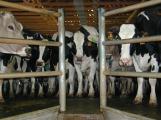14
Milking Parlour.
July, 2003
Conley Farm, Silverdale Flats, Mission, BC

15
Milking parlors are now the vogue, and this has changed what was a somewhat messy chore to a sanitary scientific operation with a whole series of valves with which the operator must be knowledgeable. The milk is never touched by human hands. But the heart of the operation is the animals themselves. As can be seen in this picture and the following one, modern day milking is a far cry from what it was when Annie Hill started milking by hand.
16
A view of the cows being hooked up to the milking machines.
July, 2003
Conley Farm, Silverdale Flats, Mission, BC

17
Binding Grain.
1940
Shook Farm, Hatzic Island, BC

18
Life on the dairy farm involved more than simply milking the cows, whether it was done in the barns by hand, or by overseeing the milking machines. Good hay was vital to keeping the cows in tip-top shape. Milton's father would make silage from hay in the 1920s, using a large steam engine to power a hay cutting machine. A gas engine would come to replace the steam engine, and electricity would eventually come to be the main source of power in the 1930s.
19
Lindell Family and a hay mower.
1920
Mission, BC

20
Annie Hill remembers a time long before electricity, even before animal power, when haying was mostly accomplished with human power:
Finances commenced to improve and we were able to purchase a horse-drawn mower. Previous to that time, the neighbours helped each other and all the hay was cut with a scythe-long days of mowing all day, their scythes kept razor-sharp by rubbing them on a stone every little while.
When the grass was sufficiently dried it was turned with forks.
21
Jack and Wiliam (Bill) Heptonstall running grain binder.
1935
Hatzic Prairie, Mission, BC

22
We went along and made it into windrows. Edith and I could help with this. The next step was to cock it, and Edith and I did a lot of this. Together we would place our forks into a bunch of hay and place it thus building a cocků. We became very hot, and then would sit in the shade of a cock to rest a bit and have a drink of oatmeal water. It had been discovered by the men that if rolled oats were soaked in a bucket of water until it was somewhat milky in colour, they could drink any quantity without becoming ill, as they did drinking plain water. Besides, it was a tasty drink.
23
Haying on the Gibbard farm, Grandfather Gibbard on the rake.
1940
Cedar Valley - Mission, BC

24
Then came the hauling. With a broad rack on the wagon, the load was carefully built, one standing on the load and placing the forkfuls as they were passed up by two or three pitchers-then driving to the next cock. I learned to be skilled at building the load, and a good load was equal to a ton of hay.
25
Trailer loads of hay at the Conley Farm.
1 July 1986
Conley Farm, Silverdale Flats, Mission, BC

26
Annie must have been happy with the advent of forage harvesters: cutting machines that would go out into the fields and thresh the hay. In time, tall silos full of curing hay would become familiar sights on farms. In the early twenty-first century, however, silos are disappearing from the farming landscape. Puffy white marshmallows now dot the haying field - these silage bales save the work of hauling bales of hay to be piled high in the silo
27
Calf Club.
1920
Hatzic Prairie, Mission, BC








